Origins of the Golden Trout
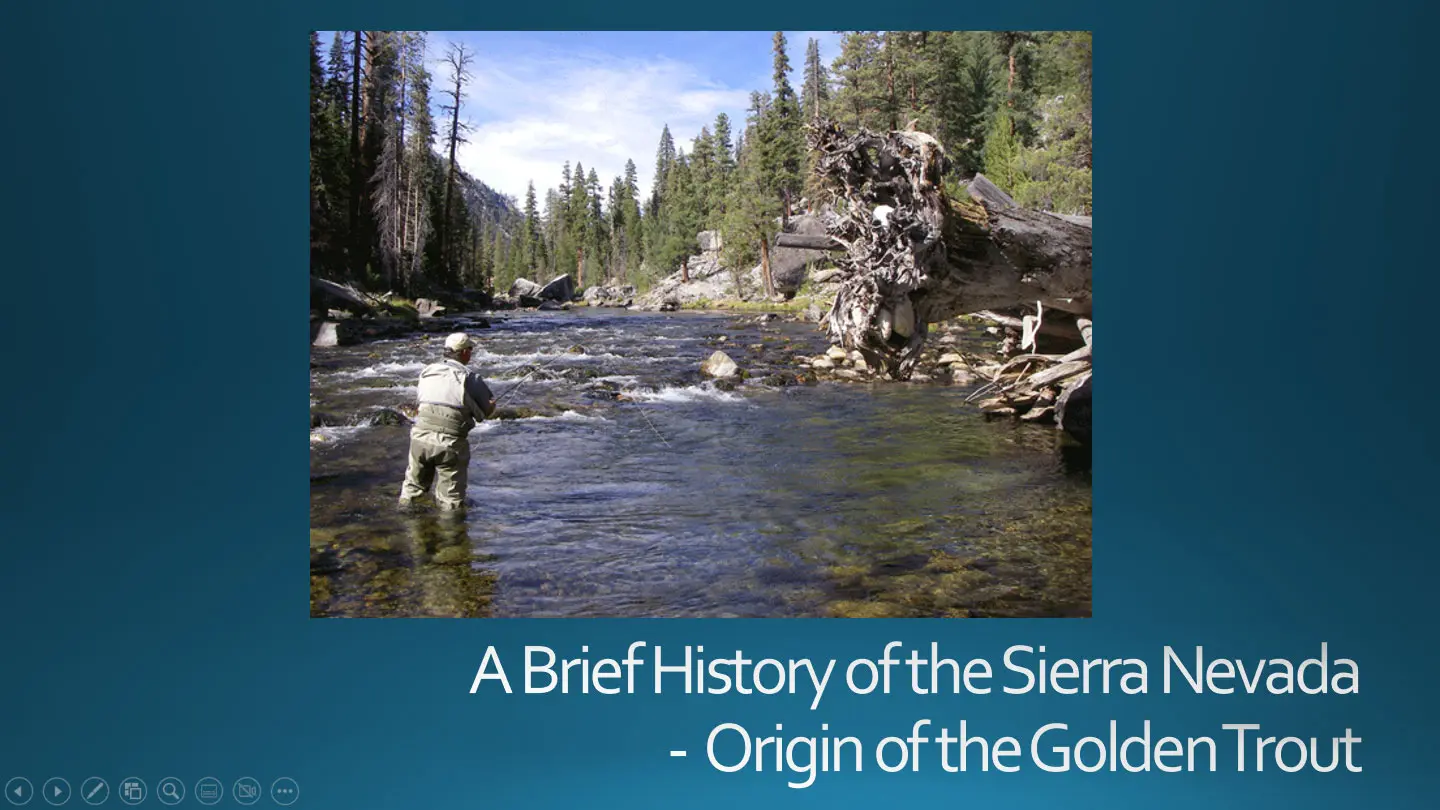
Within the Southern Sierra is a wilderness that inhabits what many consider the most beautiful trout in the world. The main Kern River, particularly the upper regions, have a strain of rainbows that many consider a “world class” fishery for fly fishermen. The caveat is that is not easy to reach either by horse back, by hiking, or by car.

There are five factors that influenced the origin of the Golden Trout subspecies: 1) The formation of the Sierra Nevada mountain range, 2) Glacial Activity, 3) Creation of the Kern Canyon Fault, 4) Incursions of Coastal Rainbows and Redbands, 5) Development of a subspecies over a 70,000 year period.
Golden Trout Complex
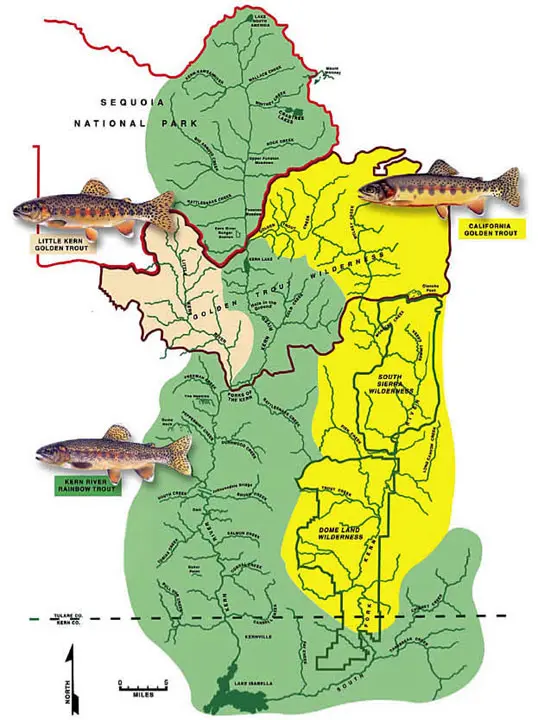
Golden Trout Historical Range
There are actually three subspecies of Golden Trout that developed within the Southern Sierra. Each of these subspecies came originally from the Coastal Rainbow and the Sacramento Redband. Our State Fish, the Golden Trout (Oncorhynchus mykiss aguabonita), is from the SF Kern watershed. It is native to Golden Trout Creek (tributary to the Kern River), Volcano Creek (tributary to Golden Trout Creek), and the South Fork Kern River. The other two rainbow trout subspecies also known as “Goldens” are the Little Kern golden trout (O. m. whitei), found in the Little Kern River basin, and the Kern River rainbow trout (O. m. gilberti), found in the Kern River system. Together, these three trout form what is sometimes referred to as the "golden trout complex".

This is the typical size of Golden Trout one would encounter within the region. There are other areas where the trout reach 20 inches or more. To identify a genetically pure Golden Trout look for a vivid red to red-orange stripe on the lower jaw and belly as well as the lateral line. The back is a deep olive-green, fading to bright gold on the sides of the fish.
About ten parr marks are centered on the lateral line and are usually present through adulthood. Body spots are large, round, dark, and concentrated near the caudal peduncle and on the dorsal and caudal fins. Spots are not usually present below the lateral line. Paired fins are orange, and some have white or yellow tips preceded by a black band. The dorsal fin also with a white to orange tip.
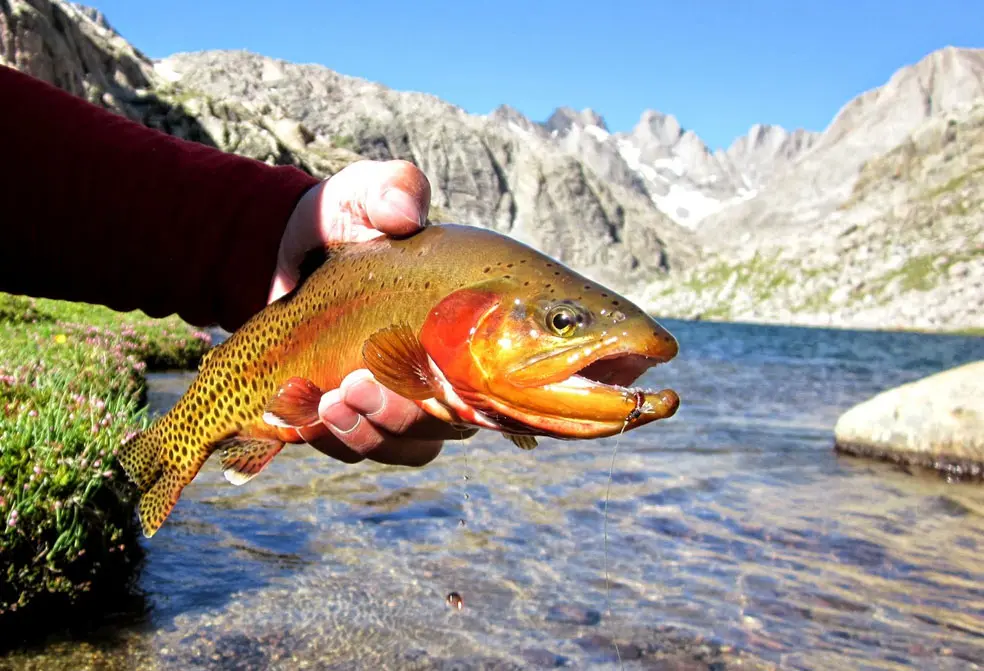
Goldens can also reach 18-20 inches within the basin lakes of the Sierra Crest. It takes an effort to reach these basin lakes but the rewards of large Goldens makes it all worth the effort. The reason these fish are larger than within the streams is due to a smaller surviving population not needing to compete for a limited food source. Within these high elevation areas, most of the food has to be blown onto the surface by the wind. The spawning areas are limited, so the numbers of Goldens are limited as well. Practice good Catch and Release procedures. These wild fish can live 7-8 years within these waters.

Kern River Rainbows can reach up to 20 inches within the upper reaches of the Kern River. Little Kern Goldens are usually 6-8 inches within the headwaters of the Little Kern River.
Historic Range of Native Trout
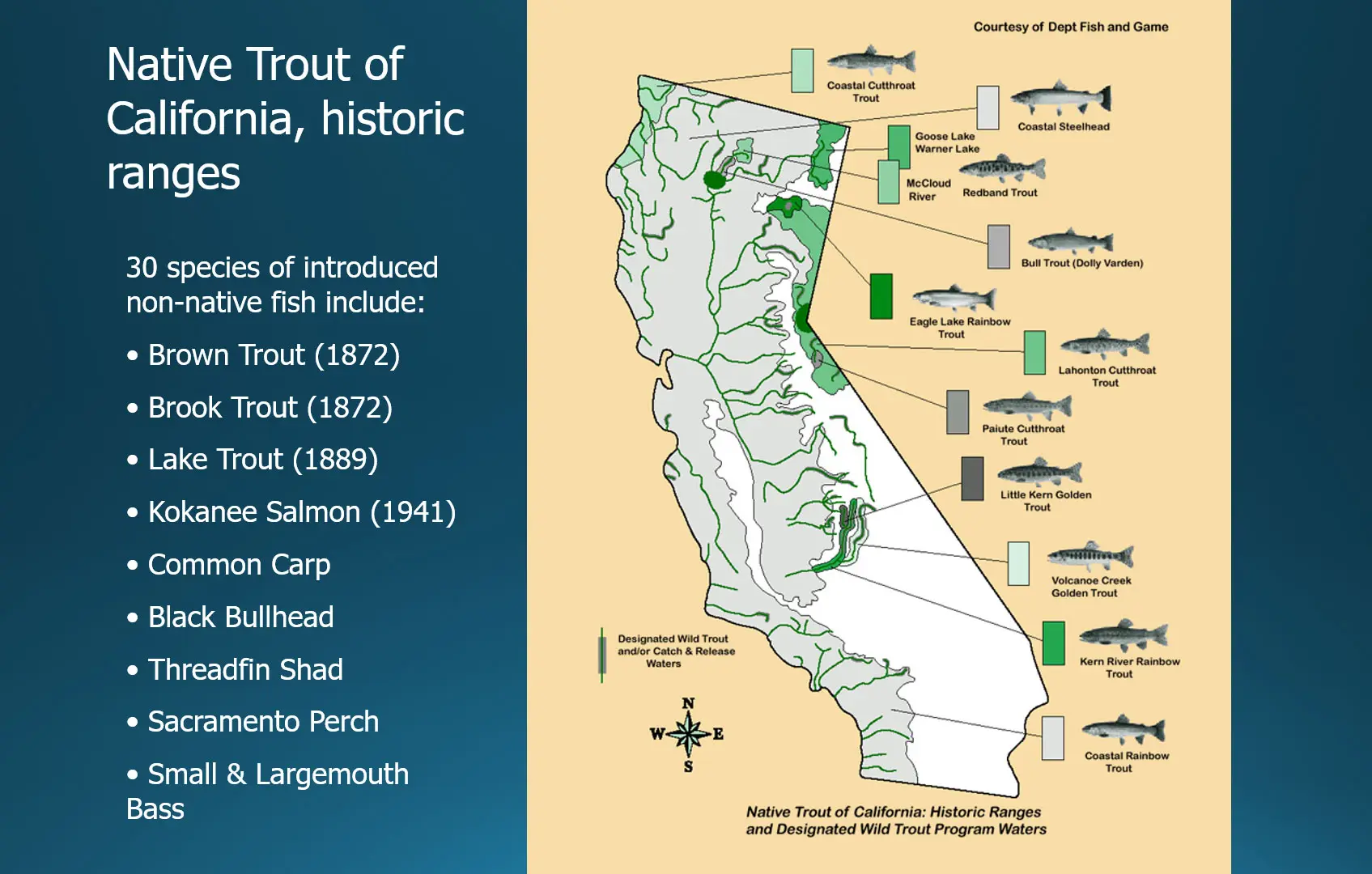
There is an estimated 1,404 lakes in the Sierra Nevada above 7,900 feet and larger than 2.5 acres. Surveys have shown that trout exist in 63% of those lakes, the rest fishless. Golden Trout occurred in 36% of the lakes, Rainbows 33%, Brook Trout 16%, Brown Trout 8% and Cutthroats less than 1%.
Another study of 649 lakes in Inyo, Sierra, and Toiyabe found that 90% of the lakes contained trout. Within this study, 60% contained Brookies, 36% Rainbows, 32% Goldens, and 5% Browns. Aerial plants continue today on 299 of the 649 lakes dropping 49% Rainbows and 48% Goldens.
Half of all Sierran lakes are planted with juvenile rainbows every one to two years.
Coastal Rainbow Migration
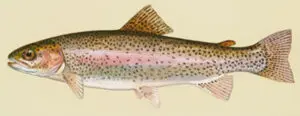
Coastal Rainbows gained access to most of California waters prior to dams. They could reach most of the Sierran waters below 6,000 feet and could not go higher due to natural barriers. If the Coastal Rainbows returned to the ocean, they were known as Steelhead. If they remained within the tributaries, they formed resident populations. If these resident populations became isolated, a subspecies was formed, particularly within the Shasta region and the Golden Trout complex.
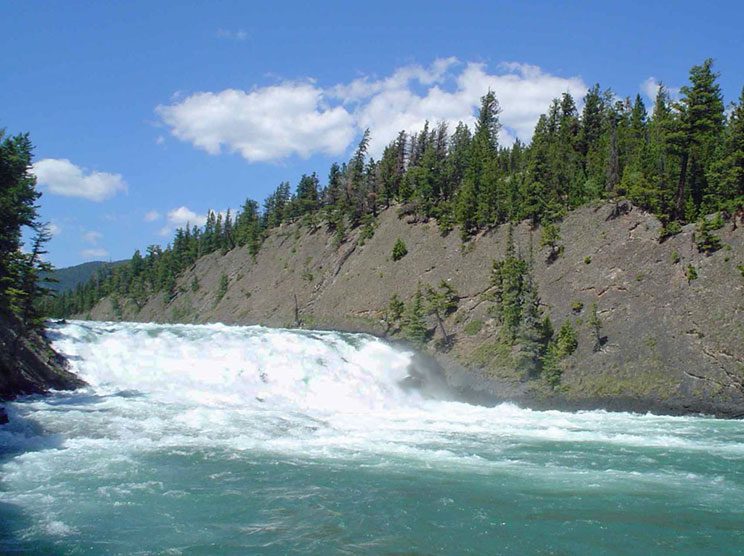
Coastal Rainbows had access to these isolated regions due to Glacial runoff. During the Glacial runoff, Coastal Rainbows could reach areas that were isolated due to natural barriers and allowed Coastal Rainbows to reach the higher elevations of the Sierra within the Shasta and Kern Basin regions. As the runoff subsided, these fish were able form distinct populations without further ingress of Coastal Rainbows. It is estimated that most of the Golden Trout complex was isolated again about 70,000 years ago.
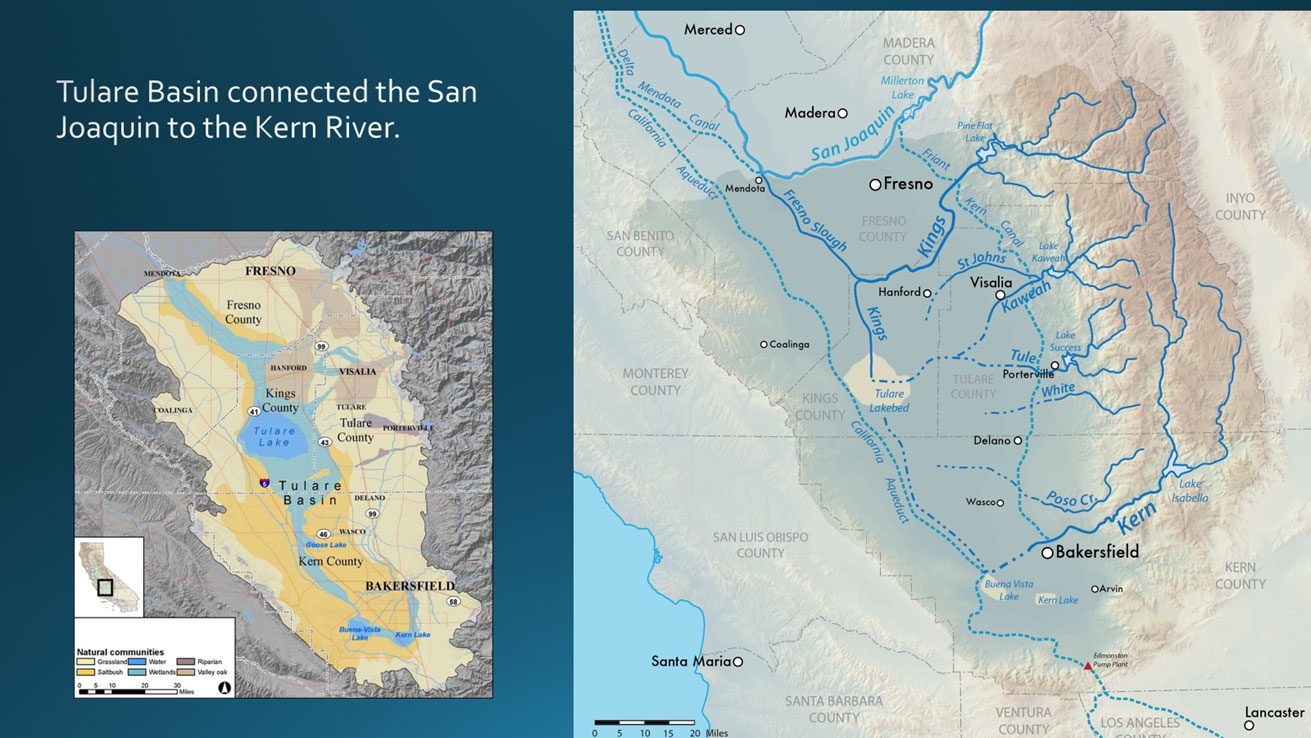
The flooding of the Tulare Basin is an example of how fish could migrate through areas that would normally be inaccessible. The San Joaquin river had a water connection through Tulare Lake to the Kern River. This allowed Coastal Rainbows and Redband Trout from the Shasta region with access to the Kern River.
Formation of the Kern River
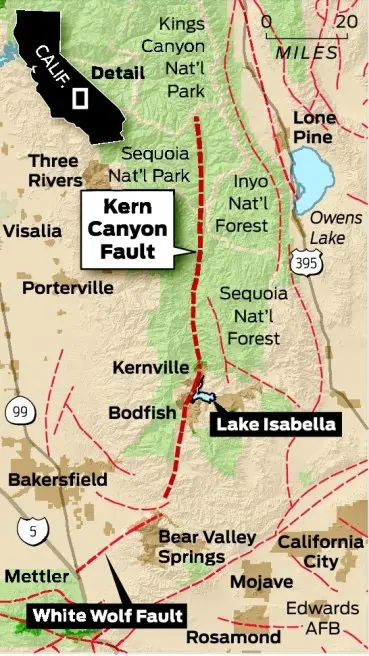
Another geologic event occurred earlier which formed the Kern River, the Kern Canyon Fault. A 93-mile fault was created during the early Cretaceous period , 100 million years ago, by the subduction of the Farallon plate and the North American Continental plate. This fault created an entry into the high elevations of the Sierra for the Coastal Rainbows by way of the Kern River. This is the only river within the Sierra Nevada that travels in a north/south orientation.
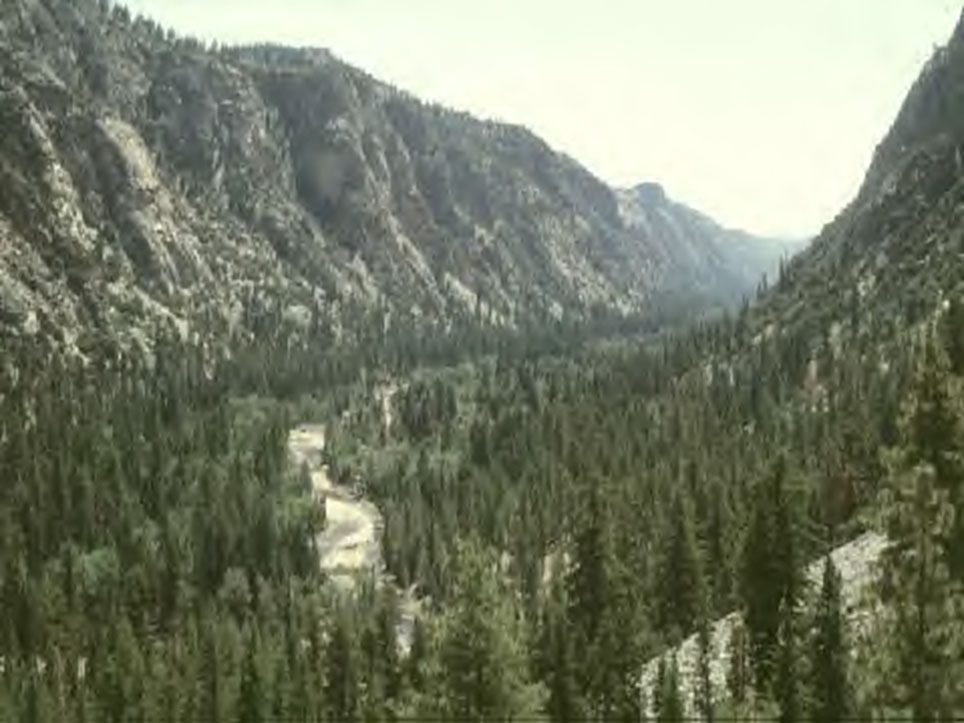
The Kern River Canyon is known for it’s deep canyon formed by the Kern River going well into the range. The depth is magnified by the tall peaks of the Southern Sierra. The area had less glaciation than the central or northern parts and left the rugged peaks exposed. It is mostly granitic rock with some metamorphic intrusions. In the south, the Sierra Nevada range meets the structurally distinct Tehachapi Mountains in southern Kern County where the Garlock Fault meets the San Andreas Fault. The Sheepheaven Redband was recently identified as one of the trout from the Shasta Region that made its way up the Kern river during the glacial runoff period. 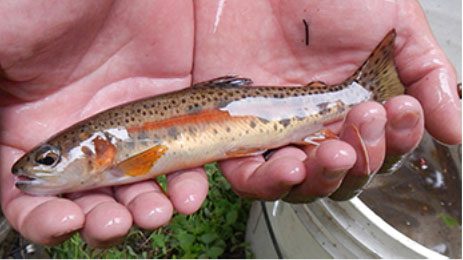 Genetically, the Little Kern Golden is very similar to the Sheepheaven Redband. The Little Kern Golden has the same number of scales, vertebrae, and pyloric caeca (intestinal filaments) as the Sheepheaven Redband.
Genetically, the Little Kern Golden is very similar to the Sheepheaven Redband. The Little Kern Golden has the same number of scales, vertebrae, and pyloric caeca (intestinal filaments) as the Sheepheaven Redband.
Volcano Golden Trout

The Volcano Golden is our State Fish and evolved within the South Fork Kern region. This area extends from Domeland, through Monache Meadows, and into the Golden Trout Creek area. The common name of "Volcano" comes from the tributary of Volcano Creek that flows into Golden Trout Creek. It was from this creek that the Golden was first studied and identified. The Volcano Golden has some specific markings. First, there are rounded spots only on the tail, peduncle, and dorsal fin. There will be no spots on the belly, head, or the body in front of the peduncle. Second, there are 9-10 parr marks that remain visible throughout the life of the fish. A crimson stripe will be visible along the lateral line. This crimson coloration will also be seen on the belly. Third, the body has a golden hue throughout but this is variable depending upon the UV light reflection coming off the substrate. And, finally, look for white tips on the fins with a dark line separating the white from the remaining fin coloration.
Little Kern Golden Trout
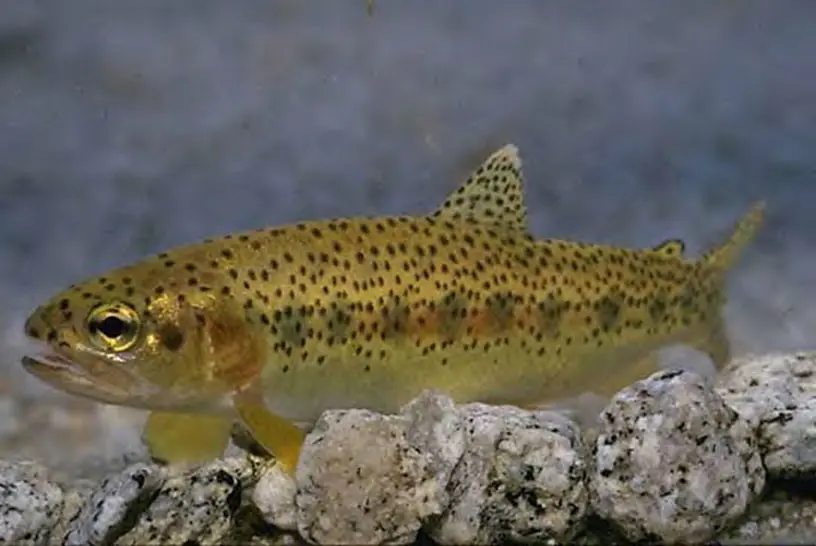
The Little Kern Golden evolved within the Little Kern River drainage. There are some major obstacles near the confluence of the Main Kern which kept other fish from inhabiting this water. The Little Kern Golden has irregular-shaped spots from the tail to the nose, primarily along the top half of the fish. The belly should be spotless. The body has a golden hue which is also quite variable. There are 9-10 parr marks which remain visible through the lifecycle. A faint crimson stripe is visible along the lateral line. The dorsal, pelvis, and anal fins will have a white tip.
Kern River Rainbow
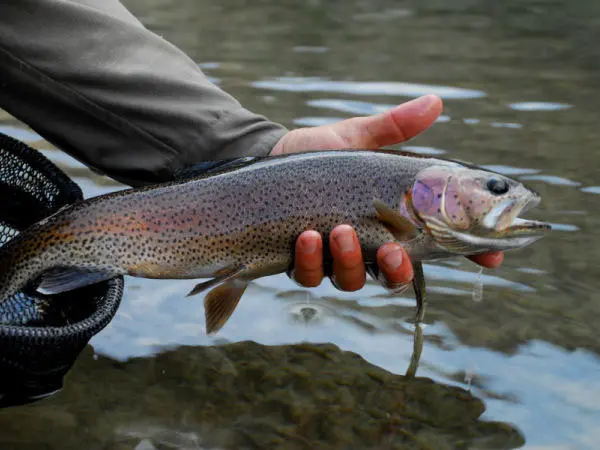
The Kern River Rainbow (KRR) is the third subspecies of the Golden Trout complex. It's native region is one the Main Kern from above Lake Isabella to the headwaters in Sequoia National Park. Due to considerable hybridization with recent rainbow trout introductions, most identify this subspecies as Kern River Rainbows above Durrwood Camp which is below the Forks of the Kern. The KRR can be identified with irregular-shaped spotting over all of it's body, including its belly. The body has a Bronze Olive hue with faint parr marks. The Crimson stripe is visible but can be faint along the lateral line. The dorsal, pelvis, and anal fins will have a white tip.
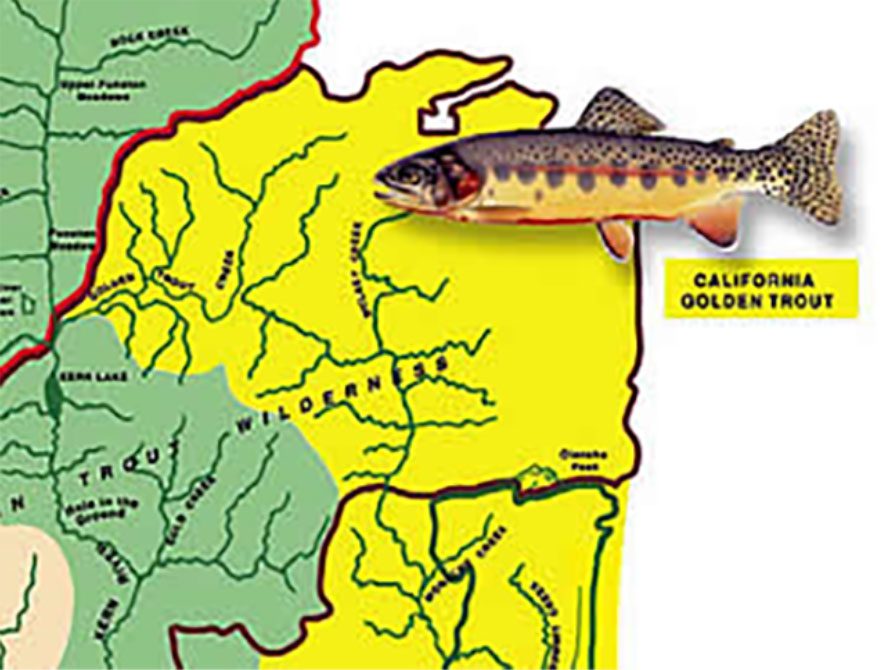
If you look closely at the native range of the Volcano Golden or visit Tunnel Meadow, you will note that Golden Trout Creek is not within the South Fork Kern watershed. The two streams are about 200 yards apart. You might wonder how this fish was able to extend into a neighboring watershed across a land bridge. Golden Trout Creek empties into the Main Kern but a series of waterfalls over 800 feet in height keep the Kern River Rainbows from migrating into their habitat.
Groundhog Cinder Cone
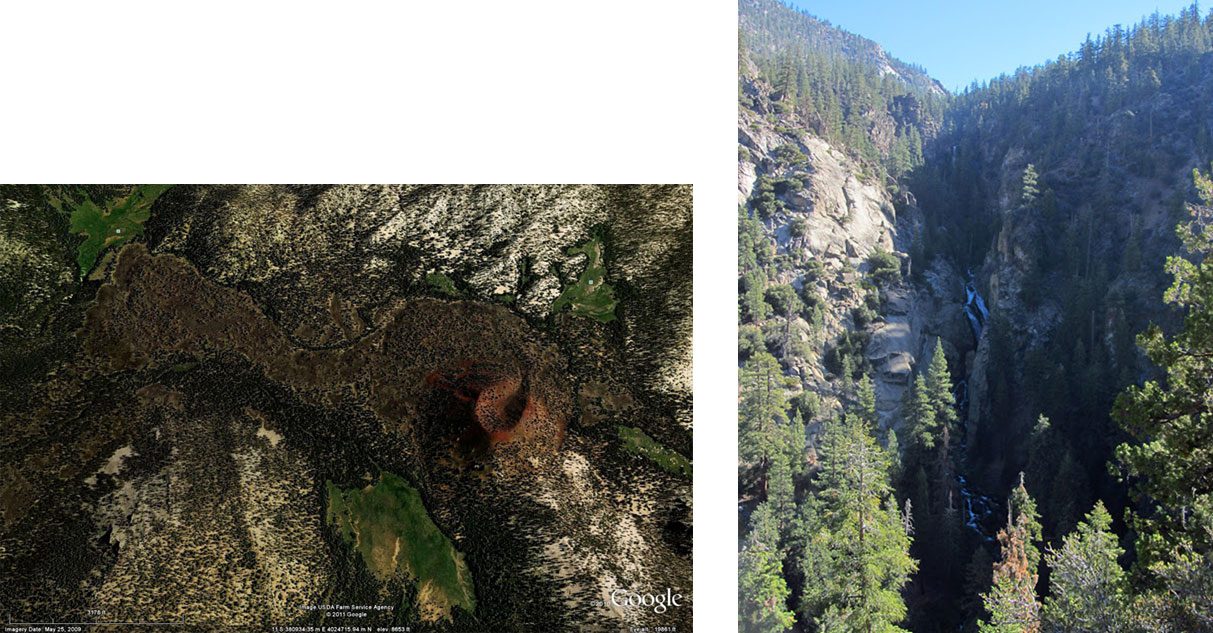
The answer is the eruption of the Groundhog Cinder Cone about 5,000 years ago. The eruption caused lava to flow into Golden Trout creek and change its flow into a westerly direction. The creek plummeted into the Main Kern from an 800 foot waterfall (Volcano Falls) and the Volcano were isolated into a smaller watershed unable to join the South Fork Kern.
Human Influences
Starting in the late 1800's, there have been a number of human influences that have affected the Golden Trout complex. Most notable was the introduction of the Volcano Golden into the Cottonwood Lakes region.
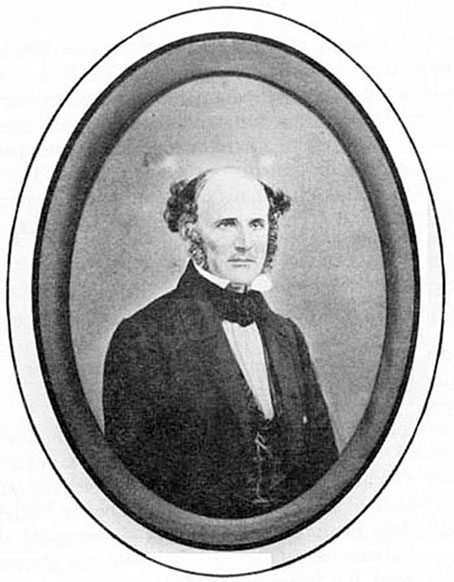 Colonel Sherman Stevens arrived in Inyo County in 1865, a year before it became a county and in the midst of an Indian War. He owned a Silver mine east of Owens Lake in 1867 and built a sawmill in Cottonwood Lakes to provide timber and fuel for the mines. The Colonel also liked to fish so he and his brother carried 13 Golden Trout fingerlings in a coffee pot from Mulkey Creek (tributary of South Fork Kern River) to Cottonwood Creek in CA in 1876.
Colonel Sherman Stevens arrived in Inyo County in 1865, a year before it became a county and in the midst of an Indian War. He owned a Silver mine east of Owens Lake in 1867 and built a sawmill in Cottonwood Lakes to provide timber and fuel for the mines. The Colonel also liked to fish so he and his brother carried 13 Golden Trout fingerlings in a coffee pot from Mulkey Creek (tributary of South Fork Kern River) to Cottonwood Creek in CA in 1876.
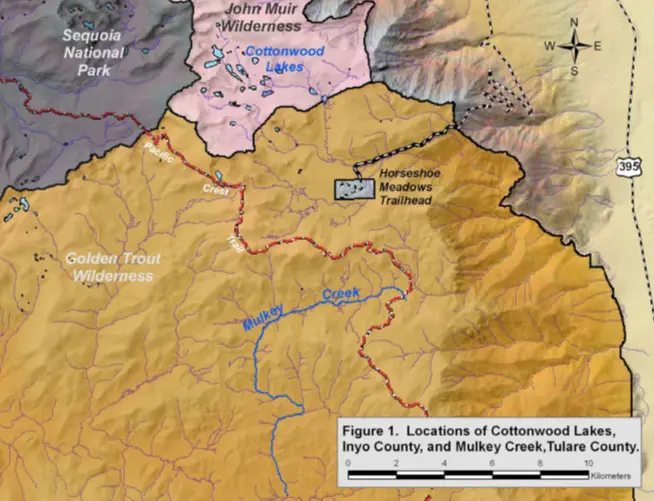
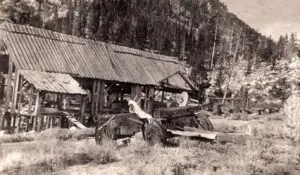
Cottonwood Creek Mill
This picture of the mill was taken in 1960. The mill was built in 1873. An Ox-drawn wagon is in the foreground. Cottonwood Creek flows directly through the mill providing the hydraulic power for the mill. It was within this creek that Colonel Stevens planted the first Golden Trout in Cottonwood Creek in 1876. The area became easily accessible due to the construction of Horseshoe Meadow Road in 1967 and vandals burned the structure 6 months later after the road was opened.
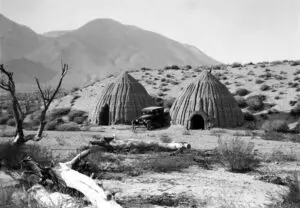
Charcoal Kilns
Colonel Stevens would bring the logs down from Cottonwood Creek to the valley floor by using wood flumes and made kilns to create charcoal. This charcoal was delivered by mule trains to many mining areas on the Eastern Sierra to provide the heat necessary to extract silver, gold, and lead from the ore. You can still visit these kilns along Hwy 395 south of Lone Pine.
 E. H. Edwards, a member of the 1885 Lone Pine Fire Brigade, and five friends planted 100 golden trout taken from Cottonwood Creek fish into Cottonwood Lakes in 1881. Within a few years, the Goldens reached 5 lbs. in size.
E. H. Edwards, a member of the 1885 Lone Pine Fire Brigade, and five friends planted 100 golden trout taken from Cottonwood Creek fish into Cottonwood Lakes in 1881. Within a few years, the Goldens reached 5 lbs. in size.
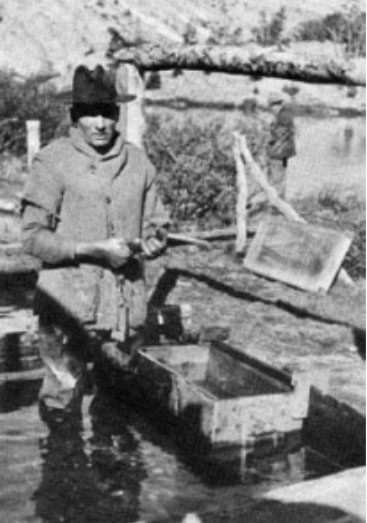
Egg Collection at Cottonwood Lakes
A "spawning station" was established at Cottonwood Lakes in 1917 by the Calif Division of Fish and Game which became the source of Golden Trout eggs. Eggs were sent to the Whitney Fish Hatchery starting in 1918 for the rearing of Golden Trout. Between 1928 and 1938, the eggs were also shipped to the National Fish Hatchery in Bozeman, MT. Various lakes in MT were stocked with eggs from the Cottonwood Lake station. Eggs had to be continually collected as Golden Trout could not be raised as brood stock like other trout.
It was at Mount Whitney Fish Hatchery that the first attempt to propagate the famous California golden trout was undertaken in 1917, with eggs taken at Cottonwood Lakes. The early success of the operation was due to the skill and resourcefulness of George McCloud, who was in charge of Mount Whitney Hatchery and the golden trout egg collecting operations at Cottonwood Lakes during the period 1917 through 1941. Over 500,000 eggs were collected over this time period. The egg collections continued until 1998, when it was realized that the Golden Trout population of Cottonwood Lakes had been contaminated with the gene pool of Rainbow Trout. The Whitney Hatchery closed in 2008 following a massive mud slide that destroyed many of the ponds and water supplies. No Golden Trout propagation is taking place at this time. There is some interest in having the Kern River Fish hatchery provide pure strain Kern River Rainbow but they are working on infrastructure problems.
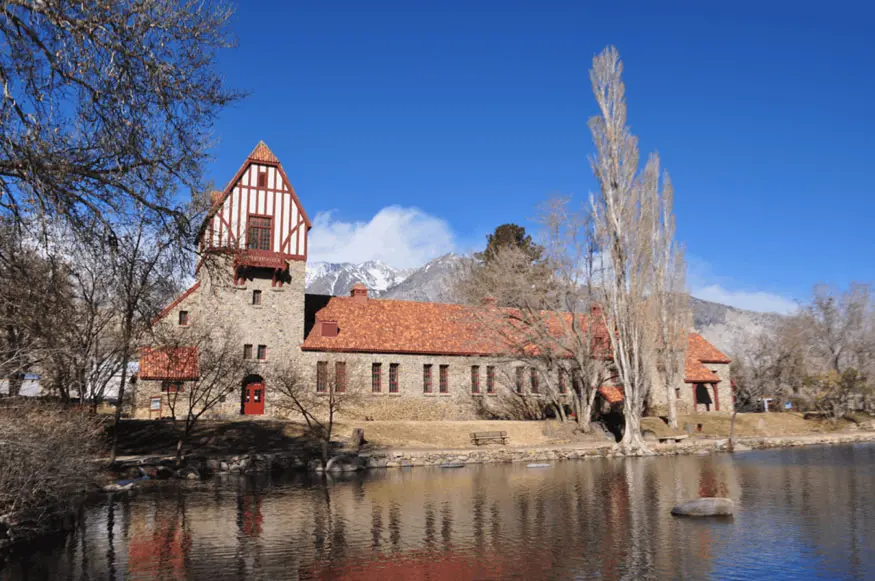
Mount Whitney Fish Hatchery
CDFG has ten fish hatcheries within the state producing over 26 million fish for stocking each year, 13 million “catchable” trout, 1.2 million “subcatchable”, and 12.3 million “fingerlings”. Since 1917, over 35 species of non-native fish have become established within California. In 1980, based upon the Leopold Report, all National Parks ended fish planting. In Kings, Yosemite, and Sequoia National Park about 40% of the lakes are once again fishless.
 Early trout plantings within the Sierra were by mule trains but this method gave way to aerial methods starting in the 1940’s. Aerial planting provided an ease to plant literally thousands of trout to many streams and lakes so that by 1970, 85% of all the lakes and 90% of all the streams within the Sierra had fish. Problems were created by this mass planting effort as it is suspected that sometime around 1960, an aerial shipment of Rainbow Trout fry were planted within the Cottonwood Lakes creating hybridization. Cottonwood Lakes could no longer provide pure Golden Trout Eggs after 1998 and the waters were opened to the public for fishing. Aerial planting was severely curtailed starting in 2002 due to concerns with amphibian restoration programs. CDFW still has their 1981 Beechcraft King Air 200 and aerial planting began again in 2022.
Early trout plantings within the Sierra were by mule trains but this method gave way to aerial methods starting in the 1940’s. Aerial planting provided an ease to plant literally thousands of trout to many streams and lakes so that by 1970, 85% of all the lakes and 90% of all the streams within the Sierra had fish. Problems were created by this mass planting effort as it is suspected that sometime around 1960, an aerial shipment of Rainbow Trout fry were planted within the Cottonwood Lakes creating hybridization. Cottonwood Lakes could no longer provide pure Golden Trout Eggs after 1998 and the waters were opened to the public for fishing. Aerial planting was severely curtailed starting in 2002 due to concerns with amphibian restoration programs. CDFW still has their 1981 Beechcraft King Air 200 and aerial planting began again in 2022.
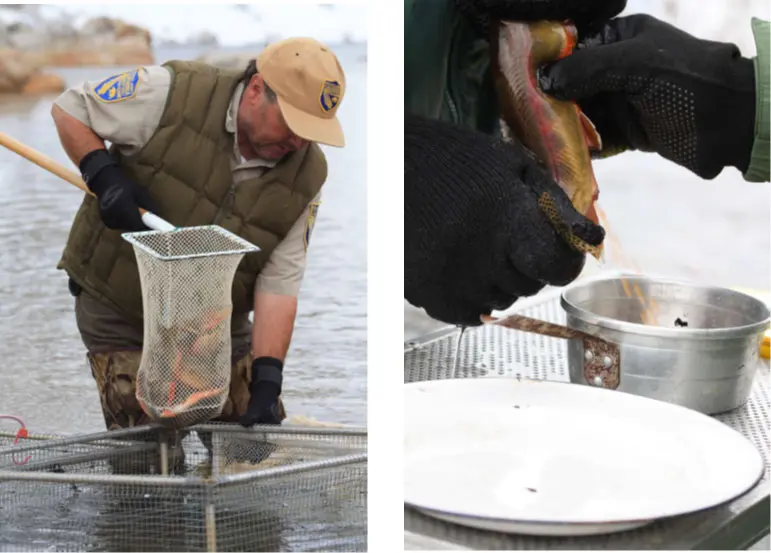 Eggs continued to be collected at Cottonwood Lakes until 1998. Genetic variation within the Golden Trout at Cottonwood Lakes was first identified in the early 1960’s. But it has been speculated that gene pool contamination may go back to the 1930’s.
Eggs continued to be collected at Cottonwood Lakes until 1998. Genetic variation within the Golden Trout at Cottonwood Lakes was first identified in the early 1960’s. But it has been speculated that gene pool contamination may go back to the 1930’s.
Cottonwood Lakes was the epicenter for egg collections of the Golden Trout program. After suspected contamination, it was closed to all fishing from 1966 to 1998.
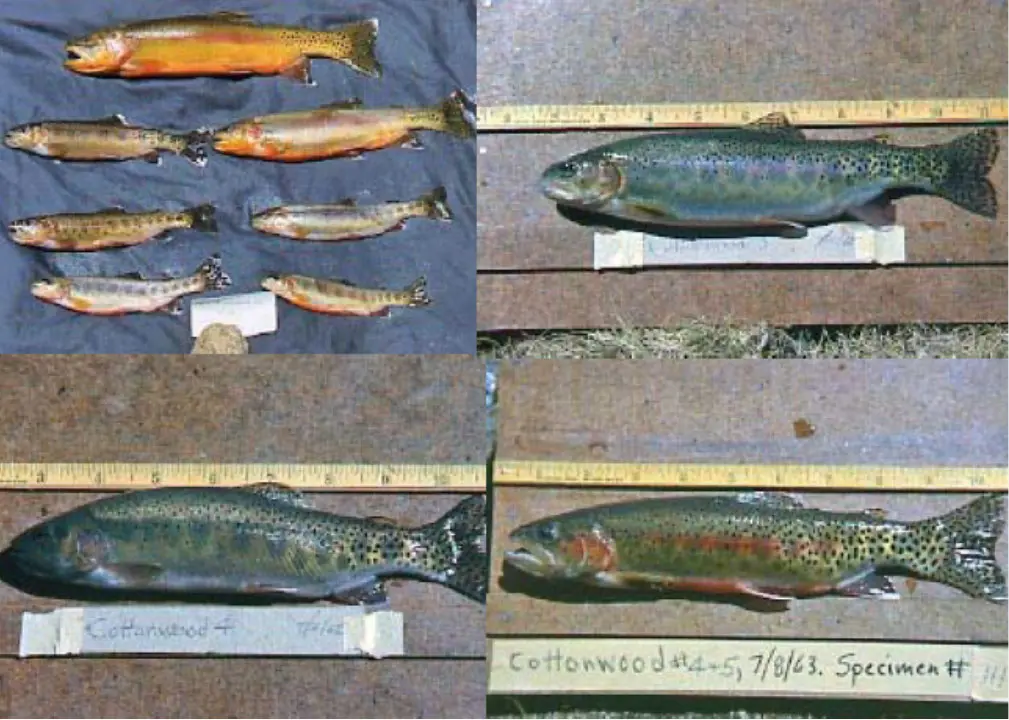
The Cottonwood Lakes Basin lies just above 10,000 feet about 12 miles southwest of Lone Pine, CA. which is at 3500 feet elevation. The basin is on the eastern side of the Sierra Crest with 5 mountain passes providing access to the Kern River drainage to the west. Mt. Langley (14,027’) is about 6 miles northwest of the trailhead at Horseshoe Meadows and Mt. Whitney (14,494’) is about 11 miles northwest.
There are six numbered lakes at Cottonwood Lakes with the sixth lake being fishless. Goldens are found in each of the lower five lakes. The lakes were closed to fishing from 1966 to 1998 for Golden Trout brood stock protection. Access to the lakes opened in 1998 for fishing from the mandate of the Wild Trout Program. Today, Lakes #1-4 are open for fishing from Sept 1st to Nov. 30th, with a 2 trout limit and a 14" minimum. Lake #5 is open year-round, a 2 trout limit. All lakes are artificial lure or fly only.
Volcano Golden
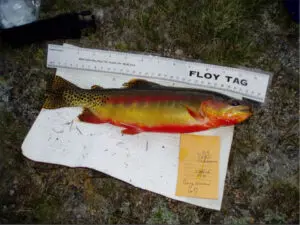
Starting in 2004, the search for “genetically pure” Volcano Goldens was conducted by UC Davis.
Samples were taken throughout the historical range, including the Wind River, Wyoming population which was started by eggs collected at Cottonwood Lakes in 1920-1925. No additional eggs were sent to Wyoming after 1932.
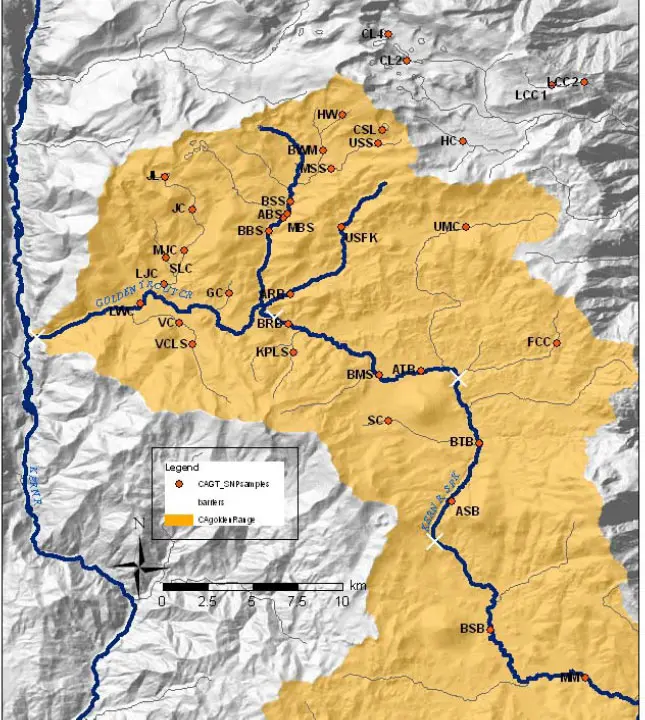
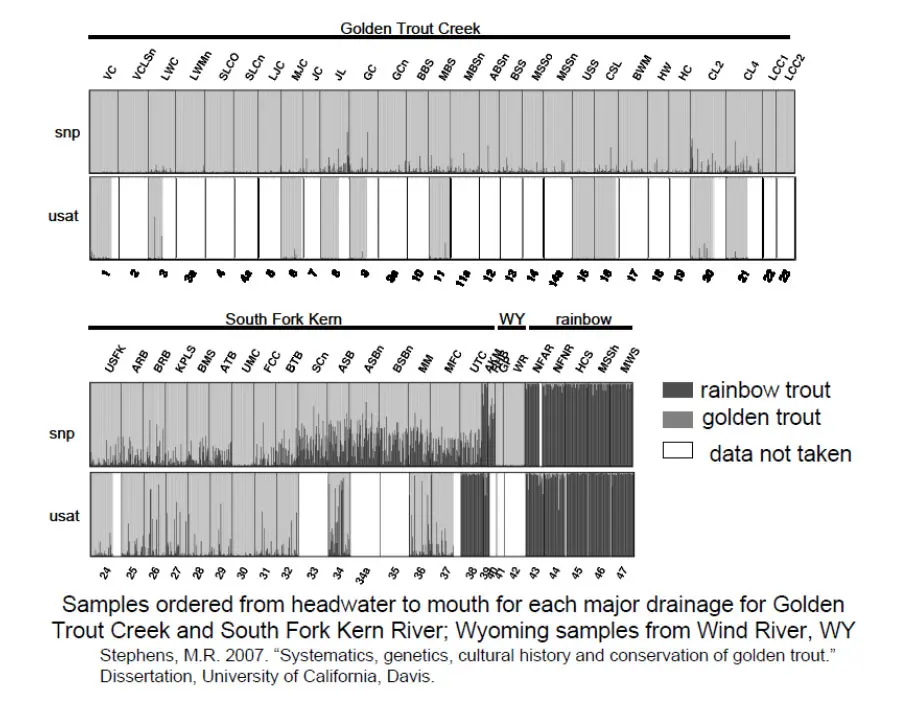
The Wyoming population was considered pure and the only population within the Golden Trout region that had an identical purity was the Volcano population at Volcano Creek. The data showed that the purity of the Volcano Golden diminished as the range was further from Volcano Creek within Golden Trout creek. The hybridization was pervasive throughout the South Fork Kern.
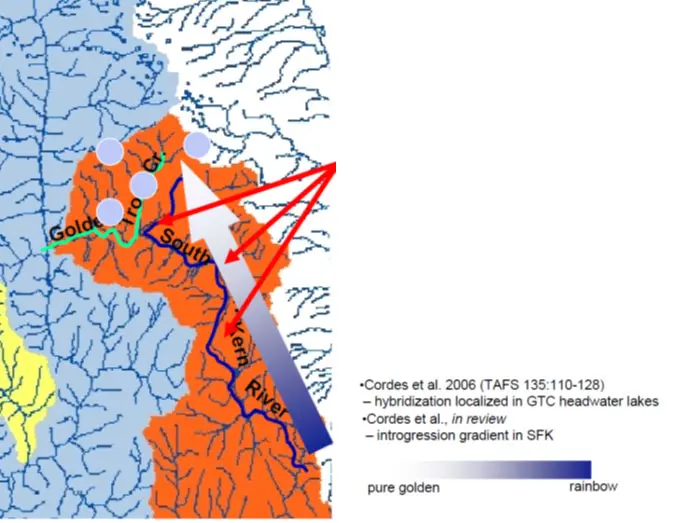
Efforts were made to remove Hybridized Goldens from headwater lakes of Golden Trout creek by gillnetting in 2001-2003. Fish were removed from both Chicken Spring Lake and Rocky Basin Lakes.
Other areas of the Golden Trout region have had problems with competition with introduced species and hybridization with transplanted rainbows. Brown Trout are aggressive predatory fish that fill eat small Goldens as well has limited available food. Brookies do well in much of the same habitat and compete for a limited food supply.
The fish within the South Fork Kern are hybridized Goldens from many years of transplanted rainbows being stocked with them. These fish are also in competition with introduced Brown trout that will diminish their numbers. The only pure strains of Goldens found within this watershed is on upper Mulkey Creek.
Three barriers were built on the SF Kern to restrict Brown Trout migration. Brown Trout up to 5 lbs were found in Tunnel Meadows (1969) eating most of the Goldens.
- Ramshaw Barrier – 1970
- Templeton Barrier – 1975
- Schaeffer Barrier – 1983 (Rebuilt 2003)
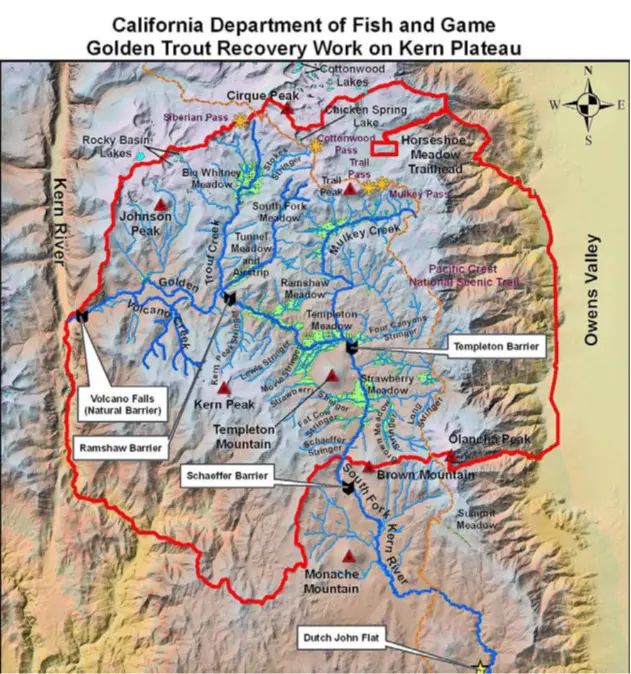
Fish introductions into the SF Kern are a threat to the Goldens. Rainbows interbred with the Goldens and Brown trout competed for scarce habitat. These fish were removed by both chemical and physical means and barriers were constructed to control their movement into Golden trout waters. Schaeffer Barrier was built within Monache Meadows in 1983 and had to be rebuilt in 2003. The Templeton Barrier was built in Templeton Meadow and the furthest upstream barrier is the Ramshaw barrier below Tunnel Meadow. Ten chemical treatments were conducted on the South Fork Kern above these barriers from 1969 to 2000. Early surveys showed good success. However, surveys in 2024 indicated that a substantial number of browns have still migrated past all three barriers.
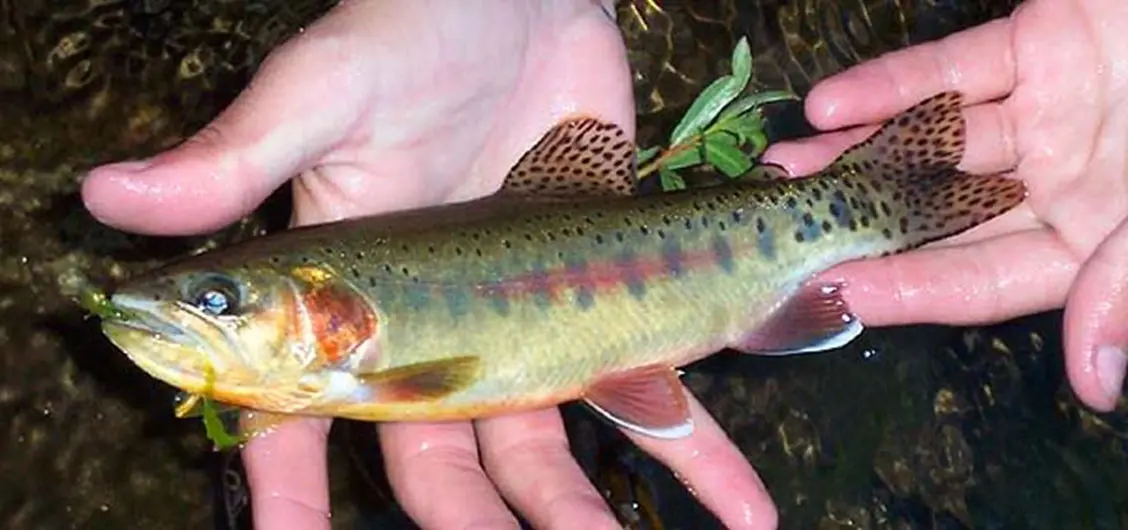
Typical hybridized Volcano Golden on the South Fork Kern. Note the spotting that occurs along the back up to the nose.
Kern River Rainbow
The Upper Kern is the home waters of the Kern River Rainbow (KRR). Most of the range of KRR is hybridized. There are small streams that have natural barriers that have “pure” strains and these streams are estimated to be about 12 miles in length with up to 30,000 fish. The southern boundary for KRR considered “Pure Strain” is Durrwood Camp about 8 miles upstream of Johnsondale Bridge. CDFW recently conducted surveys throughout the watershed in search of “pure” Kern River rainbow trout. Genetic studies found a population in a headwater lake of Big Arroyo. Steps are being taken to capture a portion of this population and rear them in a hatchery.
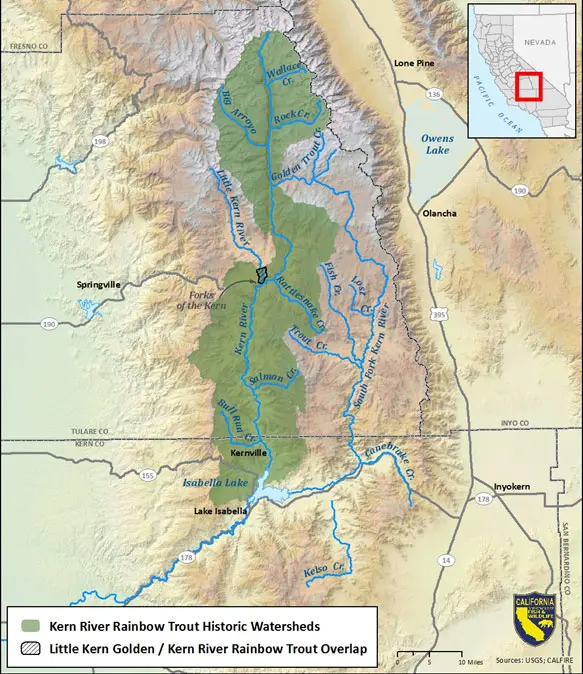
The Kern River Hatchery has been discussing the raising of pure strain Kern River Rainbows for over 20 years. They have rebuilt the facility and are collecting specimens for a brood trout program.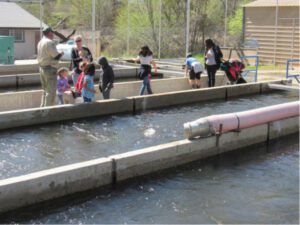
The hatchery was set up to propagate Little Kern Goldens from 1981 to 1997. Contamination shut the program down. The hatchery was renovated and is now intending to propagate Kern River Rainbows in which pure strains which were located within the headwaters of Big Arroyo.
The pure strains are found within the tributaries of the Kern River. The Heritage Trout program considers any Kern River Rainbow caught above Durrwood Creek to be pure enough for the program. Actual genetic data is sketchy.
Remnant pure populations of the Kern River Rainbows have been found in the Kern River above Durrwood Creek, in Upper Ninemile, Rattlesnake and Osa Creeks, and possibly in upper Peppermint Creek.
Little Kern Golden
The Little Kern Golden is found within the Little Kern watershed. It also was subject to considerable hybridization and competition from invasive trout over the last 100 years. Rainbows were introduced in 1930-1941 in Little Kern River ,Alpine Creek, Clicks Creek, Mountaineer Creek, Peck's Canyon , and Shotgun Creek . Browns were introduced to Clicks Creek in 1935 and Brookies to many Little Kern Drainage waters in 1930-1941.
In 1973, Early genetic studies, using allozymes, identified only six remaining pure populations of Little Kern Golden Trout. Five of these occurred in the endemic habitat occupying only 10% of 100 stream miles in the basin having a total of less than 5,000 pure LKR trout. One was identified outside the native habitat.
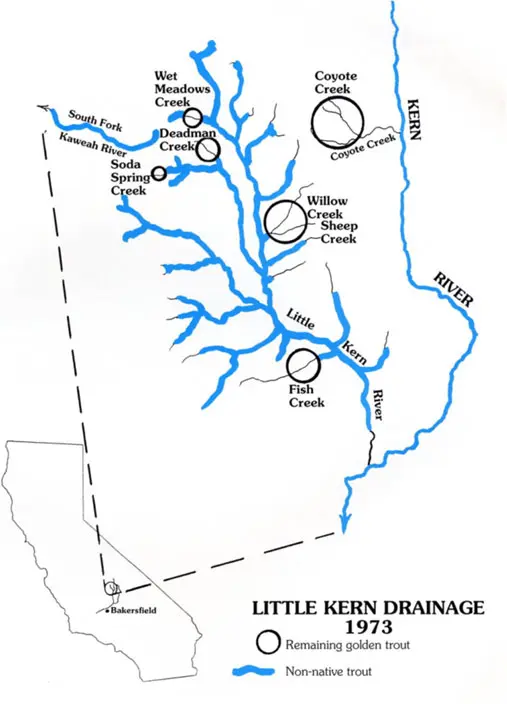
Little Kern Golden remnant populations
During the late 1980's over 100 chemical treatments of Rotenone were conducted within the Little Kern Drainage. 27 barriers were constructed and 80,000 hatchery raised LKR were transplanted back into the chemically treated sections. By late 1990’s , 70% of the LKR habitat was restored to pure strains.
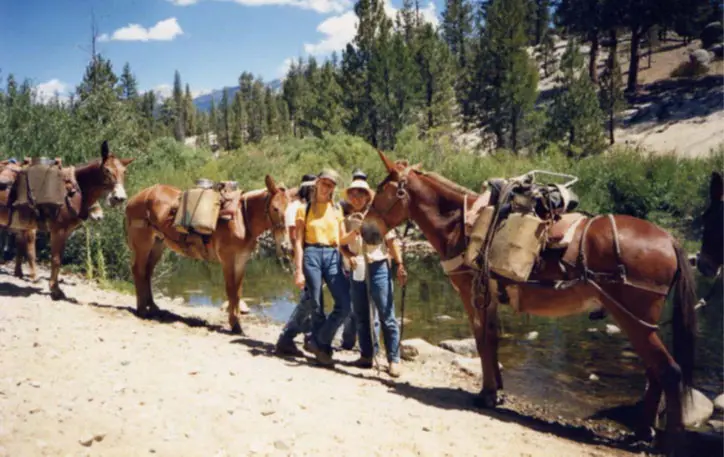
Little Kern Golden Recovery Crew
This was truly a success story for CDFW. The region was transformed from an invasive species problem to a “pure” Little Kern Golden region once again. 20 years has gone by since the transformation and the region remains healthy.
Additional Impacts (Human and Natural Influences)
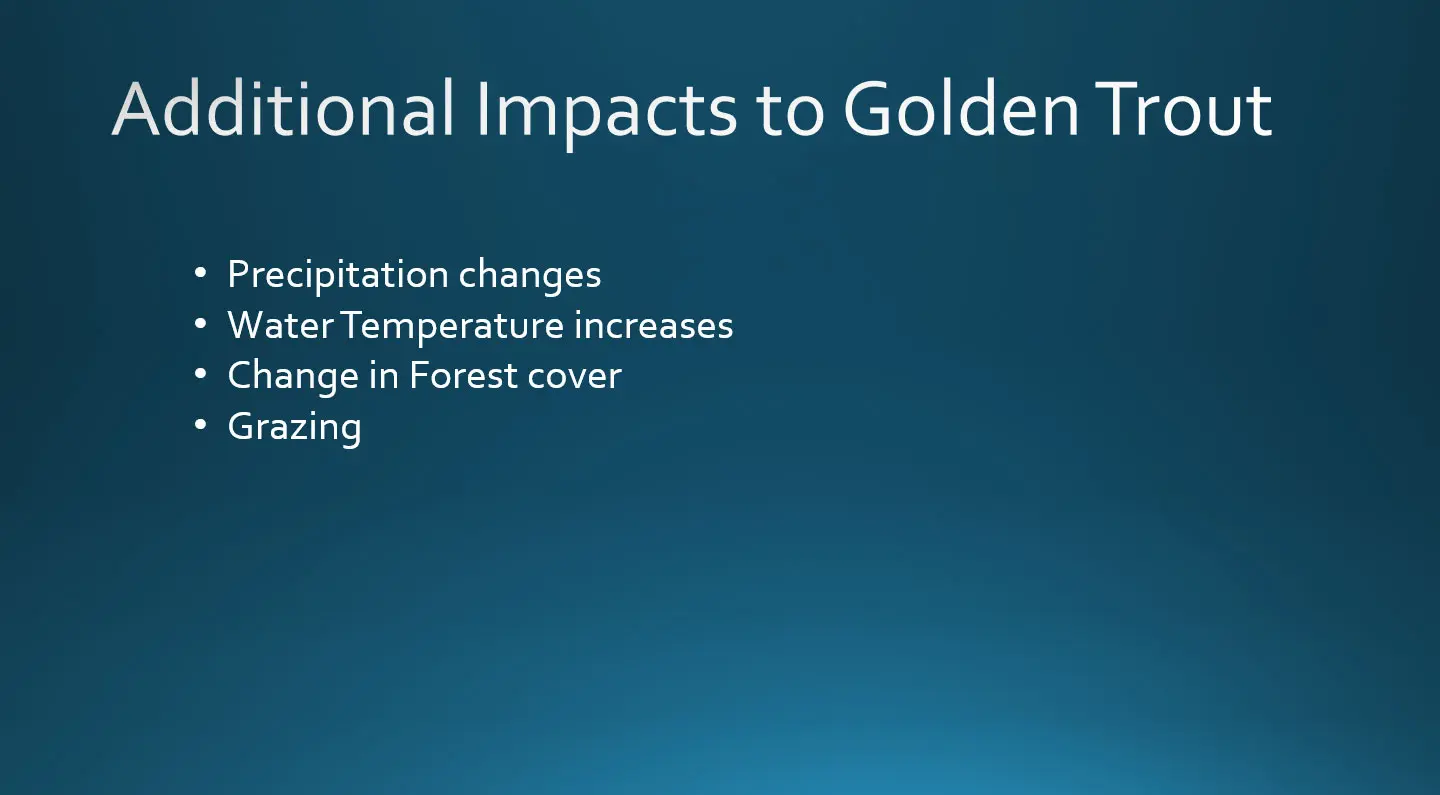
There will be additional impacts to the Golden Trout with changing temperatures and water precipitation. One concern is whether there will be enough water to support these high elevation streams. Looking at tree ring data, the wettest period of time during the last 1500 years has been the last 150 years. During this 1500 period, the Sierra experienced two 200 year droughts. 
Temperatures in the Sierra Nevada region have increased in correlation with higher Atmospheric CO2 levels since the 1950’s.
It is anticipated that by 2100, 80 years from now, that temperatures will be rising 7 to 10 degrees throughout the Sierra Nevada.
Forests have been considered a carbon sink , holding almost 70% of all carbon emissions. As surface temperatures increase, soil bacteria is breaking down carbon material and creating a forest that is emitting more carbon and it is retaining.
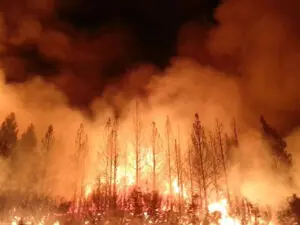 Huge amounts of carbon are released from wild fires. Trout Unlimited finished a study looking at the effect of climate change on Trout populations. Their findings were that 50% of the Cutthroats within western waters will be lost over the next 70 years due to these higher temperatures. These higher temperatures will impact all three Golden Trout subspecies.
Huge amounts of carbon are released from wild fires. Trout Unlimited finished a study looking at the effect of climate change on Trout populations. Their findings were that 50% of the Cutthroats within western waters will be lost over the next 70 years due to these higher temperatures. These higher temperatures will impact all three Golden Trout subspecies.
In addition, the 5 year drought we experienced in 2011-2017 coinciding with warmer winters, resulted in a very high Bark Beetle population that affected many of our conifers. Some areas of the Sierra experienced over 50% conifer mortality from Bark Beetle infestations. The conifer stands were additionally weakened by overly dense stands due to a lack of Forest Management. These factors played a major role in the intensity and number of wildfires throughout the Sierra.
The Future of the Golden Trout Complex
The future of the Golden Trout will require a concerted effort in the following areas:
- Protect the genetic Integrity of the Species. Pure strains of Volcano Golden are limited to about 9 miles of stream, presently.
- Get the CO2 levels back to historical levels, bringing down temperatures.
- Eliminate Grazing within the Golden Trout habitat.
- Maintain the historical range of the Goldens by excluding invasive species.
- Adapt water management policies to ensure adequate water for native fish.
- Use Forest Management tools to create healthy forests and assist in the survival of the Golden Trout.


Great history Steve. That is on my list before I kick the bucket.
Thanks!